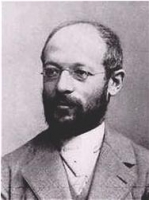| 格奧爾格·齊美爾 | |
| 齊默爾 | |
|
閱讀格奧爾格•西美爾 Georg Simmel在百家争鸣的作品!!! | |
格奧爾格·齊美爾(Georg Simmel,1858年3月1日-1918年9月28日,又譯為西美爾或齊默爾),德國社會學家、哲學家。主要著作有《貨幣哲學》和《社會學》。是形式社會學的開創者。
生平與影響
齊美爾1858年3月1日生於柏林一個信仰基督教的猶太商人家庭,為七個孩子中最年輕的一個。父親早逝(1874年死),其後齊美爾被一位音樂出版商(Julius Friedländer (1827–1882))收養為被監護人,在這段期間之後,他留下豐厚遺産,足以令齊美爾無經濟煩憂。於Friedrichwerderschen 中學畢業後,齊美爾在柏林大學修讀歷史、民族心理學和哲學,後轉為哲學與藝術史,並以拉丁文為副修。1881年獲得博士學位,並於1885年獲得講師資格,此年開始以自由職業者(或私人性質的哲學講師)身份任教於柏林大學。
1890年,齊美爾與女作傢Getrud Kinel成婚。他們的寓所坐落於柏林夏洛騰堡區(Charlottenburg-Westend),到訪者中有裏爾剋、鬍塞爾、李凱爾特、萊普修斯夫婦和馬剋斯·韋伯夫婦。由於當是學術體製以及既有的反猶主義背景,齊美爾一直無法獲得正式教職,也在這些當時頗有影響力的朋友的幫助下,齊美爾到1900年方剋服德國學術管理機構的阻撓,得到柏林大學無薪編外哲學教授(eine unbezahlte außerordentliche Professur)一職。1908年他在海德堡大學的求職,也因為歷史學者謝佛(Dietrich Schäfer)反對而失利。
他的授課出自於富於魅力的演講特色,對邏輯、倫理、審美、宗教社會學、社會心理學和社會學等問題的探討相當受學生喜愛。另外,他也在報紙上發表對當時社會問題的各種看法,因此齊美爾的影響力遠超出了既有學術範圍的框架,作傢圖霍夫斯基、剋拉考爾乃至恩斯特·布洛赫都對他評價很高。
齊美爾的哲學觀屬於先驗觀念範疇的認識論(von vorbestimmten ideellen Kategorien der Erkenntnis)。他認為,隨着演進的選擇,人的認識會不斷嚮前發展,且個體性(Individuum)也會因此發展開來,但是,人類在思想上是無法獲得生活的全體性(die Totalität des Lebens)。這麽說,人類不斷發展文明,意圖獲得更多的生活可能,在不知不覺中,卻産生了意想不到的更多東西,反過頭來使自己偏離的原本道路。諸如貨幣産生,為了便利生活與交易而生,但最後衍生出來的新的、高度匿名化的現代生活,卻使傳統社會一去不返。這種論調類似韋伯在看資本主義與科層制度,對現代社會的影響。
在他1900年出版的重要著作《貨幣哲學》中,齊美爾認為,貨幣對社會、政治和個體性的影響將持續擴大。貨幣經濟的發展,不但徹底摧毀了封建制度的統治,還讓現代民主制度發展起來。根據齊美爾的觀點,現代社會的貨幣組是以自身為目的而推展—人類的自我感覺(Selbstwertgefühl),以及人們對生活的安排都會透過貨幣這種媒介日益確定下來。
齊美爾發現,貨幣成了上帝,因為它已經指嚮絶對目標的絶對工具。在現代社會,銀行比教堂更大、更有勢力。銀行是現代城市的中心。人的一切感官知覺都與貨幣有關。但人仍應保有自由權,在貨幣之外拓展視野——例如建立基於精神交往的社交圈子。藉此,令貨幣的權勢止於文化領域:藝術傢不僅僅為錢,更應為自己的精神而創作。
相對於魏森(Leopold von Wiese),齊美爾是形式社會學(formale Soziologie)的奠基者之一。形式社會學的目的是,針對所有社會現象,抽象出一些形式予以探討。因此內容不會是討論的重點。齊美爾的學說特別試圖探討的是社會連結以及關係的形式,比如在不同社會關係中的層級(Hierarchien),如在家庭、國傢等領域。
1903年齊美爾發表了《大都會與精神生活》(Die Großstädte und das Geistesleben)論文,為其都市社會學的奠基之作;但這一份研究發表後並未引起什麽回響,但其後間接影響到了美國的社會學發展。 在齊美爾生前,他的著作就被一本本的翻譯成意大利語、俄語、波蘭語以及法語。在德國,他對後世學人的影響也非常大,比如盧卡奇、馬丁·布伯、馬剋斯·捨勒、卡爾·曼海姆以、魏斯以及後來的法蘭剋福學派。年輕時期的恩斯特·布洛赫就深受齊美爾影響,他在第一次世界大戰時就曾與晚年的齊美爾針對愛國主義進行批評。
齊美爾等人跟當時的大學者們都有往來,比如他跟滕尼斯、韋伯以及宋巴特在1909年設立了德國社會學學會(Deutsche Gesellschaft für Soziologie (DGS))。
齊美爾終身並未建構一個連續不變的哲學,或者是社會體係,當然他也沒有自成一個學派。他人生最後的一段時間在現在法國史特拉斯堡任教授度過,從1914年開始任職,並從此獲得正式講師資格。
齊美爾對後續社會研究的世代影響很大。他有公開的作品有15部,以及超過200篇專業文章或報紙評論。在都市社會學以外,他對後來的角色社會學影響也很大,但是他並未精確地運用過“社會角色”(sozialen Rolle)這個詞彙。在他《社會學》一書(1908年出版)內論衝突的一章,也是後來衝突社會學(Lewis Coser等人的學說)的基礎。
作為哲學人,齊美爾經常針對生活哲學進行討論。探討此一方向的學者,如法國的伯格森,他的作品也受到了齊美爾思想的影響。齊美爾的出版其實並非全部都是社會學類的。在1908-1917年間,他就沒有發表社會學類的文章,而是哲學(1910)、歌德(1913)以及林布蘭(1915)。
1911年他在佛萊堡大學獲得國傢學科榮譽博士(Ehrendoktorat der Staatswissenschaften)的職位,以榮耀他為社會學奠基的成果。在1914年他纔獲得在Kaiser-Wilhelm-Universität(現為史特拉斯堡大學)的正式教職。
1918年9月26日,齊美爾病逝於史特拉斯堡,死因為肝癌。
齊美爾的社會學
齊美爾認為社會學是一門綜合性的知識(eklektische Wissenschaft)。也就是說:社會學不是單一的學問,而是一個運用其他學科總整而成的新學問。它運用了歷史研究、人類學、統計、心理學以及其他專門學科構成。在其中它所使用的並非使這些學科的原始資料,開創新的總整體係,突顯出另一層意義。作為社會學,齊美爾想要描繪人類集體生活的形式,並且試圖歸整出一些規則,再從這裏面找到個體性。因為在物理世界中,並不存在“社會”或“個體性”這樣的東西。也就是說,對於社會學而言,它所研究的對象是無法被直接觀察到的——唯有個體輪廓消失,認識上升到某種抽象層次時才能理解和把握。
齊美爾的第一個著作《論社會差異》(Über sociale Differenzierung)就在處理這樣的核心議題。他認為,現代的個體性是在持續發展,持續差異化的,並且越來越明顯。個體性的養成,其實是仰賴社會團體緊密的連帶(比如鄉村相對於都市的生活)。社會化的程度,也就在於個體在社會網絡中,跟其他個體交換、交織的復雜而深入程度,當然也影響他們形成差異化的程度。當我們致力於拓展我們的興趣範圍時,我們也為了發展我們自己個體性,拓展更多的空間。齊美爾在最後提到,社會差異化有其進化上的好處,在每個知識領域裏面,可以藉此不斷發展出來,甚至達到極微細的技術發展(技術進步、分工配置、負責組織等)。然而,這樣的細微發展也有其代價,那就是在不斷擴張、深化的社會認同網絡,其實也持續地對個體的生活世界有係統性的介入。 在這個主題上,齊美爾有兩本最主要的著作:《貨幣哲學》。這一本著作是齊美爾對大都市貨幣經濟興趣的基礎,同時也跟其他研究現代性的社會學有所連結(比如韋伯的目的理性)。他認為,現代社會將為出自於貨幣計算的巨大計算理性模型所主導,時間內的鐘點就是個例子。時間的計算與貨幣的計算,纔可能使現代性落實。
齊美爾也認為,起初人們對産品的價值,是出自主觀評估。但當社會日益復雜化以後,就會影響到社會交流的內涵。為了讓交流簡化,貨幣的地位就越來越重要。貨幣就成了反應價值的工具。在貨幣裏面,價值的世界以及具體的事物就跟他彼此混雜在一起:“貨幣如同蜘蛛,是人際社會網絡交纏的中介。”(Das Geld ist die Spinne, die das gesellschaftliche Netz webt.)貨幣就是人們比較與讓渡事物的原因。衹要能換成或貨幣,所有東西都能夠交換,因為它就是被認可的價值單位,同時也是比較的單位(所有事物都被它夷平了(Nivellierung)),在其中再也沒有事物可以以質的方式來認識。貨幣占領生活世界,就是以量的方式戰勝質,讓手段超越目的—變的衹有貨幣纔有價值,産生顛倒。最後貨幣就控製着我們,而不是原來僅是統一的功能而已。貨幣是一個毫無面目、沒有差異的東西,並且會把所有事物的價值、不可取代性通通磨平。
最後,現代性的個體性就會遭遇以下睏境:生活中所有具體的面嚮儘管已經獲得更好的進展,或許獲得某種自由,但其實又被睏住。相同的對現在的宗教、生活意義以及對未來的承諾縱使獲得了更大的發展,但在現代性裏面,貨幣經濟猶如新的宗教一樣出現,讓所有的社會與個人關係都透過它重新構成,也掌管着人們的感覺。
貨幣哲學
《貨幣哲學》乃齊美爾針對現代社會生活特徵的歸總式論述,全本分作兩大部分、六大章節。前一部為論貨幣本身,第二部分論貨幣所産生的生活型態。
比較要補充上述《貨幣哲學》部分的論述在於:貨幣並非如自然科學的自變項,可以毀滅封建、開創民主制度,這中間關鍵在於,透過貨幣在數個世紀內漸次大量運用中,已經改變人們的生活型態,其中一樣他相當強調的是如人們原本要追求more life,卻從中産生了意想不到more than life的東西。但是他也認為,現代社會在人身自由上比過去封建社會更多,原因在於人與土地關係斷裂開來了,可以自由移動(這一點在馬剋思理論中也出現過),大都會生活是其中最典型的生活型態,活在都會裏面,人們具有高度的匿名性,也顯示著貨幣交換過程中的高度匿名性。
雖韋伯對齊美爾評價很高,且法國書評曾經出現塗爾幹從道德評論《貨幣哲學》,但本書問世時評價兩極。
大都會的生活型態
也被翻譯為《大都會與精神生活》
作品簡析 首先要理解大城市精神生活的理性主義特點,大城市的精神生活跟小城市的不一樣,確切地說,後者的精神生活是建立在情感和直覺的關係之上的。直覺的關係紮根於無意識的情感土壤之中,所以很容易在一貫習慣的穩定均衡中生長。相反,當外界環境的潮流和矛盾使大城市人感到有失去依靠的威脅時,他們——當然是許許多多個性不同的人——就會建立防衛機構來對付這種威脅、他們不是用情感來對這些外界環境的潮流和矛盾作出反應,主要的是理智,意識的加強使其獲得精神特權的理智。 典型的大城市人的相互關係和各種事務往往是各種各樣的,復雜的。這使得現代的聰明才智越來越變成一種計算智慧。首先,這麽多人聚居在一起,利害關係千差萬別,他們的各種來往和活動相互間有多方面的有機聯繫,如果在約好的事情上和工作中沒有準確的時間觀念,那就會全都亂了套, 大城市生活的復雜性和廣泛性迫使生活要遵守時間,要精打細算,要準確,這不僅與它的貨幣經濟和理性主義的特點有密切的關係,而且也使生活的內容富有色彩,有利於剋服那種要由自己來决定生活方式、拒不接受被認為是普普通通千篇一律的外界生活方式的非理性的、本能的、主觀獨斷的性格特點和衝動。 另一方面,準確地一分鐘一分鐘地規定生活方式而形成最無個性的同樣的因素也在謀求最有個性的東西。當主體必須完全接受這種存在形式的同時,他們要面對大城市進行自衛,這就要求他們表現出社會性的消極行為。大城市人相互之間的這種心理狀態一般可以叫做矜持。在小城市裏人人都幾乎認識他所遇到的每一個人,而且跟每一個人都有積極的關係。在大城市裏,如果跟如此衆多的人的不斷表面接觸中都要像小城市裏的人那樣作出內心反應.那麽他除非要會分身術,否則將陷於完全不可設想的心理狀態。這種心理狀態,或者說我們面對在短暫的接觸中瞬息即逝的大城市生活特點所擁有的懷疑權利,迫使我們矜持起來,於是,我們跟多年的老鄰居往往也互不相見,互不認識,往往教小城市裏的人以為我們冷漠,毫無感情。 為什麽偏偏衹有大城市纔會引起最獨特的個人存在的欲望呢(不管它是否總有道理,也不管它是否都能成功)?我認為最根本的原因是:通過那種可以稱之為客觀精神的東西對主觀精神的優勢,現代文明的發展形成了自己的特點,即在諸如語言和法律、生産技術和藝術、科學和家庭環境問題上體現出了一種總體精神,這種總體精神日漸發展,結果是主觀的精神發展很不完善,距離越拉越大。如果我們縱觀一下一百年來由於各種事物和知識、由於教育和舒適的條件而形成的文明,用它來跟同一時期的人的文明進步比較一下(哪怕跟最高的水平比較),就可以發現,兩者之間的發展差異是令人吃驚的。在某些方面,如教養、關心體貼人和獻身精神,人的文明與過去相比反而有所倒退。這種差異的主要原因是分工的越來越細。因為分工越來越細,對人的工作要求也越來越單一化。這種情況發展到極點時,往往就使作為整體的人的個性喪失殆盡,至少也是越來越無法跟客觀文明的蓬勃發展相媲美。人被貶低到徽不足道的地步,在龐大的雇傭和權力組織面前成了一粒小小的灰塵。 還需要指出的是,大城市是超越於一切個性的文明的舞臺。在大城市裏,雄偉舒適的公寓建築、學校的集體生活方式和明確的校服制度,都說明大城市充滿着具體的無個性特點的思想。可以說,這種情況不能使個人保持自己的特點。一方面,個人的生活變得極為簡單,個人的行動、興趣、時間的度過以及意識都要由各方面來决定,他們似乎被放到河面上托着,幾乎不需要自己遊泳。可是另一方面,生活卻越來越由無個性特點的內容和現象組成,而這些無個性特點的內容和現象要排斥本來有個性的色彩和特點,這就剛好使得這種必定能産生最大特點的個性喪失了。
論流行
這是一篇論文,並非專書。事實上齊美爾書目著作不多。
齊美爾認為,在流行發展過程中兼具兩種貌似矛盾特色,一個是模仿群體特徵的“趨同”(imitation),但個體在其中卻又有一種要突顯自己的“標異”(demarcation),所以流行始終都在一窩蜂、又快速消散之間的雙元性擺蕩,原因就在此。齊美爾特別提到14-15世紀佛羅倫斯沒有流行,因為當時每個人都自有一套的穿着方式,因此無法産生趨同。 另外,流行還有一種強烈的“活在當下之感”(sense of present),強調流行是一種忘卻過去,也不想未來的運動過程。 其他在論流行裏面約略提到的,諸如第三階級的出現、流行在現代社會尤其特出原因在於國傢體製的關係、流行與忌妒的關係等等。
關於流行的社會學研究,在齊美爾之前有史賓塞的;在<論流行>之後,最出名者一個是美國布魯默的“集體選擇”研究,以及法國羅蘭·巴特的《流行體係》。 一般後世學者論流行時,往往會認為齊美爾是一個“涓滴理論”(trickle down),即他主張流行是由上階層開始帶動,下階層模仿的過程,其他研究散布過程理論者,出現由下而上、水平傳遞等觀點,認為自己是跟齊美爾傳統觀點不同的。事實上齊美爾雖有這種說法,但是並非緊扣階級觀點,衹是被後世過度詮釋。
齊美爾身後
齊美爾由於猶太人身份,加之並非完全科學化的論述,在死後與20世紀初期沒沒無聞,事實上思想卻廣為其他社會學家引用,影響甚鉅。如功能論帕森思對現代社會的觀點、法蘭剋福學派霍剋海默曾為他與韋伯的學生、象徵互動論從他觀察大都會生活上獲得理論基礎與方法論、德國哲學與社會學家哈伯瑪斯等人,而社會學家盧曼更是在1980年代後大力復興與倡導齊美爾觀點與哲學。現在,齊美爾也廣為後現代論者重視。
在兩岸三地,臺灣部分有由聯經出版社出版,劉小楓翻譯與撰寫的《金錢、性別、現代生活風格》。在中國大陸有由華夏出版社出版的《貨幣哲學》、《社會學》全本翻譯。
主要著作
- 女性的心理學(1890)
- 論社會差異(1890)
- 歷史哲學問題(1892, 第二版出版於1905/1907)
- 道德知識導論(1892/93)
- 貨幣哲學(1900)
- 羞恥的心理學(1901)
- Stefan George.一份關於藝術哲學史的研究(1901)
- 康德十六份講綱(1904)
- 時尚哲學(1905)
- 康德與歌德。現代世界觀的歷史(1906出版,1916年修訂)
- 論宗教(1906,1912修改)
- 叔本華與尼采(1907)
- 社會學—對社會化形式的調查(1908)
- 哲學主要問題(1910)
- 文化哲學全集(1911)
- 歌德(1913)
- 德國內部的改變(1914)
- 歷史時間的問題(1916)
- 林布蘭。一份關於藝術史的研究(1916)
- 戰爭與精神决斷(1917)
- 社會學基本問題(1917)
- 歷史理解的本質(1918)
- 生活觀點。四個形而上的章節(1918)
- 現代文化的衝突(1918)
Georg Simmel (/ˈzɪməl/; German: [ˈzɪməl]; 1 March 1858 – 26 September 1918) was a German sociologist, philosopher, and critic.
Simmel was one of the first generation of German sociologists: his neo-Kantian approach laid the foundations for sociological antipositivism, asking what is society?—directly alluding to Kant's what is nature?—presenting pioneering analyses of social individuality and fragmentation. For Simmel, culture referred to "the cultivation of individuals through the agency of external forms which have been objectified in the course of history." Simmel discussed social and cultural phenomena in terms of "forms" and "contents" with a transient relationship, wherein form becomes content, and vice versa dependent on context. In this sense, Simmel was a forerunner to structuralist styles of reasoning in the social sciences. With his work on the metropolis, Simmel would also be a precursor of urban sociology, symbolic interactionism, and social network analysis.
An acquaintance of Max Weber, Simmel wrote on the topic of personal character in a manner reminiscent of the sociological 'ideal type'. He broadly rejected academic standards, however, philosophically covering topics such as emotion and romantic love. Both Simmel and Weber's nonpositivist theory would inform the eclectic critical theory of the Frankfurt School.
Simmel's most famous works today are The Problems of the Philosophy of History (1892), The Philosophy of Money (1900), The Metropolis and Mental Life (1903), and Fundamental Questions of Sociology (1917), as well as Soziologie (1908), which compiles various essays of Simmel's, including "The Stranger", "The Social Boundary", "The Sociology of the Senses", "The Sociology of Space", and "On The Spatial Projections of Social Forms". He also wrote extensively on the philosophy of Schopenhauer and Nietzsche, as well on art, most notably through his Rembrandt: An Essay in the Philosophy of Art (1916).
